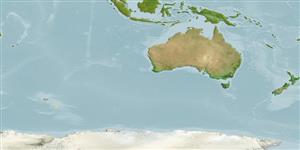>
Perciformes/Notothenioidei (Icefishes) >
Artedidraconidae (Barbled plunderfishes)
Etymology: Artedidraco: Petrus (Peter) Artedi, (10 Mar.) 1705-35 (28 Sep.), a son of a clergyman from Anundsjö named Olaus Arctaedius, in the northern part of Sweden.In 1729 he changed his name from Arctaedius to Arctædi, a name still later simplified to Artedi (Ref. 45335).
More on author: Lönnberg.
Environment: milieu / climate zone / depth range / distribution range
Ecología
marino demersal; rango de profundidad 18 - 320 m (Ref. 5181), usually ? - 200 m (Ref. 5181). Polar; 53°S - 55°S
Southern Ocean: known only from South Georgia (Antarctic waters).
Tamaño / Peso / Age
Maturity: Lm ? range ? - ? cm
Max length : 12.5 cm TL macho / no sexado; (Ref. 5181)
Sublittoral and on continental shelf from 18-320 m, with maximum abundance at less than 200 m. Main food consists of mysids , with substantial amounts of errant polychaetes, gammaridean amphipods and some unidentified polychaetes; to a lesser extent, isopods (Ref. 5181).
Eakin, R.R., 1990. Artedidraconidae. p. 332-356. In O. Gon and P.C. Heemstra (eds.) Fishes of the Southern Ocean. J.L.B. Smith Institute of Ichthyology, Grahamstown, South Africa. (Ref. 5181)
IUCN Red List Status (Ref. 130435)
Threat to humans
Harmless
Human uses
Más información
ReferenciasAcuiculturaPerfil de acuiculturaRazasGenéticaElectrophoresesheritabilidadEnfermedadesProcesamientoNutrientsMass conversion
ColaboradoresImágenesStamps, Coins Misc.SonidosCiguateraVelocidadTipo de nataciónSuperficie branquialOtolitosCerebrosVisión
Herramientas
Special reports
Download XML
Fuentes de Internet
Estimates based on models
Preferred temperature (Ref.
123201): -0.2 - 0.9, mean 0.2 °C (based on 5 cells).
Phylogenetic diversity index (Ref.
82804): PD
50 = 0.5156 [Uniqueness, from 0.5 = low to 2.0 = high].
Bayesian length-weight: a=0.00513 (0.00247 - 0.01065), b=3.13 (2.95 - 3.31), in cm total length, based on LWR estimates for this (Sub)family-body shape (Ref.
93245).
Nivel trófico (Ref.
69278): 3.2 ±0.43 se; based on food items.
Resiliencia (Ref.
120179): Medio, población duplicada en un tiempo mínimo de 1.4-4.4 años (Fec = 193).
Fishing Vulnerability (Ref.
59153): Low vulnerability (10 of 100).
Nutrients (Ref.
124155): Calcium = 69.5 [37.5, 172.9] mg/100g; Iron = 0.598 [0.241, 1.230] mg/100g; Protein = 17 [16, 18] %; Omega3 = 0.272 [0.127, 0.564] g/100g; Selenium = 14.7 [5.3, 35.8] μg/100g; VitaminA = 17.4 [3.4, 83.8] μg/100g; Zinc = 0.755 [0.483, 1.164] mg/100g (wet weight);
